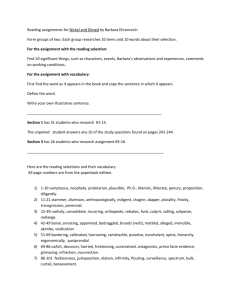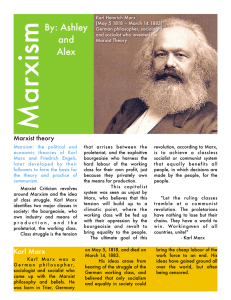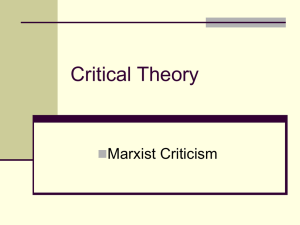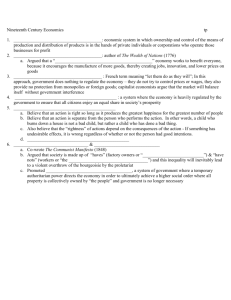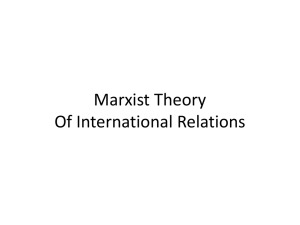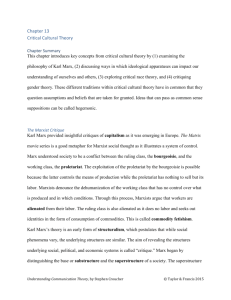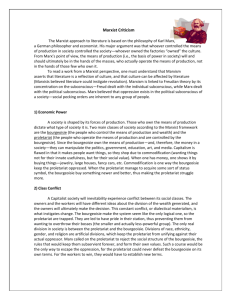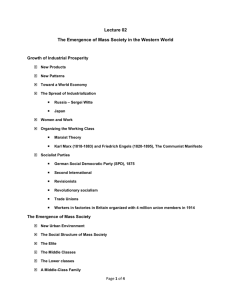WHAT IS THE MARXIST Theory - Envision Schools Project Exchange
advertisement
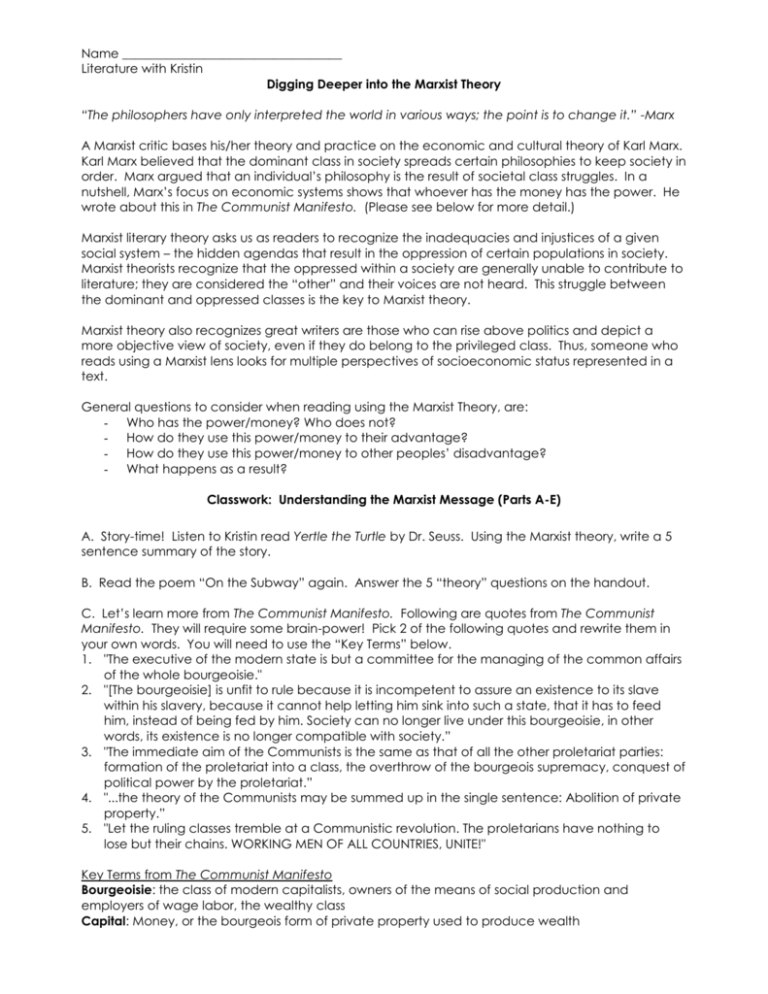
Name ___________________________________ Literature with Kristin Digging Deeper into the Marxist Theory “The philosophers have only interpreted the world in various ways; the point is to change it.” -Marx A Marxist critic bases his/her theory and practice on the economic and cultural theory of Karl Marx. Karl Marx believed that the dominant class in society spreads certain philosophies to keep society in order. Marx argued that an individual’s philosophy is the result of societal class struggles. In a nutshell, Marx’s focus on economic systems shows that whoever has the money has the power. He wrote about this in The Communist Manifesto. (Please see below for more detail.) Marxist literary theory asks us as readers to recognize the inadequacies and injustices of a given social system – the hidden agendas that result in the oppression of certain populations in society. Marxist theorists recognize that the oppressed within a society are generally unable to contribute to literature; they are considered the “other” and their voices are not heard. This struggle between the dominant and oppressed classes is the key to Marxist theory. Marxist theory also recognizes great writers are those who can rise above politics and depict a more objective view of society, even if they do belong to the privileged class. Thus, someone who reads using a Marxist lens looks for multiple perspectives of socioeconomic status represented in a text. General questions to consider when reading using the Marxist Theory, are: - Who has the power/money? Who does not? - How do they use this power/money to their advantage? - How do they use this power/money to other peoples’ disadvantage? - What happens as a result? Classwork: Understanding the Marxist Message (Parts A-E) A. Story-time! Listen to Kristin read Yertle the Turtle by Dr. Seuss. Using the Marxist theory, write a 5 sentence summary of the story. B. Read the poem “On the Subway” again. Answer the 5 “theory” questions on the handout. C. Let’s learn more from The Communist Manifesto. Following are quotes from The Communist Manifesto. They will require some brain-power! Pick 2 of the following quotes and rewrite them in your own words. You will need to use the “Key Terms” below. 1. "The executive of the modern state is but a committee for the managing of the common affairs of the whole bourgeoisie." 2. "[The bourgeoisie] is unfit to rule because it is incompetent to assure an existence to its slave within his slavery, because it cannot help letting him sink into such a state, that it has to feed him, instead of being fed by him. Society can no longer live under this bourgeoisie, in other words, its existence is no longer compatible with society.” 3. "The immediate aim of the Communists is the same as that of all the other proletariat parties: formation of the proletariat into a class, the overthrow of the bourgeois supremacy, conquest of political power by the proletariat.” 4. "...the theory of the Communists may be summed up in the single sentence: Abolition of private property.” 5. "Let the ruling classes tremble at a Communistic revolution. The proletarians have nothing to lose but their chains. WORKING MEN OF ALL COUNTRIES, UNITE!" Key Terms from The Communist Manifesto Bourgeoisie: the class of modern capitalists, owners of the means of social production and employers of wage labor, the wealthy class Capital: Money, or the bourgeois form of private property used to produce wealth Name ___________________________________ Literature with Kristin Capitalism: An economic system based on the exchange of capital (money) Communism: A form of socialism proposed by Karl Marx, which intends to reform society by advocating a revolution of the proletariat (working class) Proletariat: the class of modern-wage laborers who, having no means of production of their own, are reduced to selling their labor power in order to live, the lower class D. Read the following poem, entitled “Let’s Go, Students” by Daniel Viglietti. 1. Make a list of all the words in the poem that directly relate to Marxist references (class, power, money, revolution). 2. After reading the poem, use at least 3 of the “Key Terms” from The Communist Manifesto, and describe what the author is advocating for. Let’s go, Students by Daniel Viglietti Let’s go students, To the streets and the squares. Let’s go, For life is calling us. Let’s go, comrades, Our heads high; Who fights for something Gets it. Today it is arms, And tomorrow, what will they be? Today it is stones, Think about it. Let us march, Our fists clenched, And our hearts in revolt. Let’s us go like the river, In the streets and the squares Crying out what Artigas Said. Tyrants Will one day tremble. A cold wind, We’re going to get them We are the new Air Of the spring. Against our voice There are no barriers We will defeat The darkend air Let’s go, let’s create A new dawn. E. Critically examine the Frida Kahlo painting on the PPT/screen and answer the questions that follow. 1. In your own words, what is the message of this painting? 2. Frida Kahlo was a proclaimed Marxist. How could this painting, which is titled “Marxism Will Give Health To The Sick,” be used to further the Marxist agenda?

